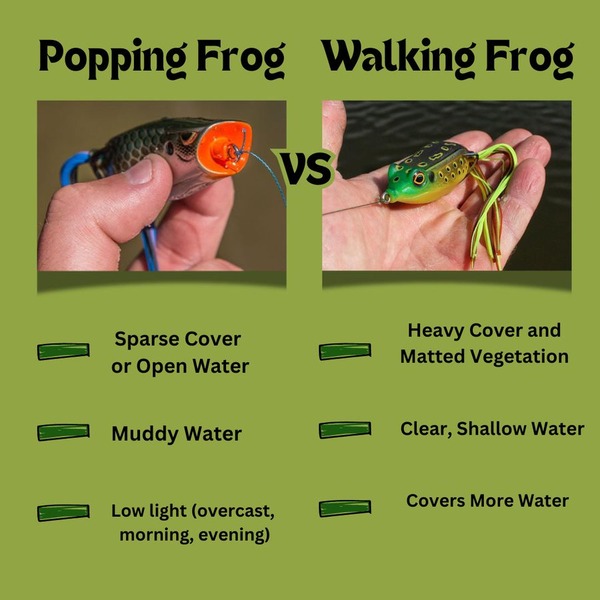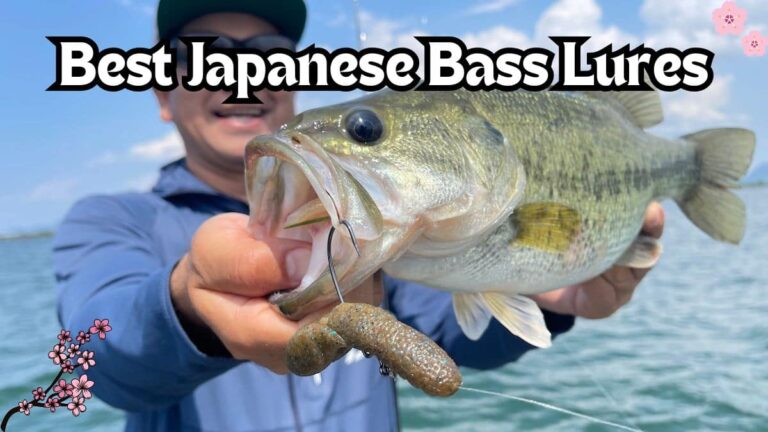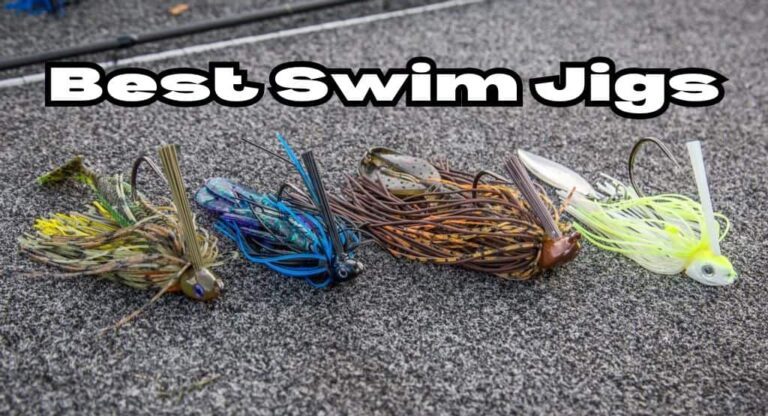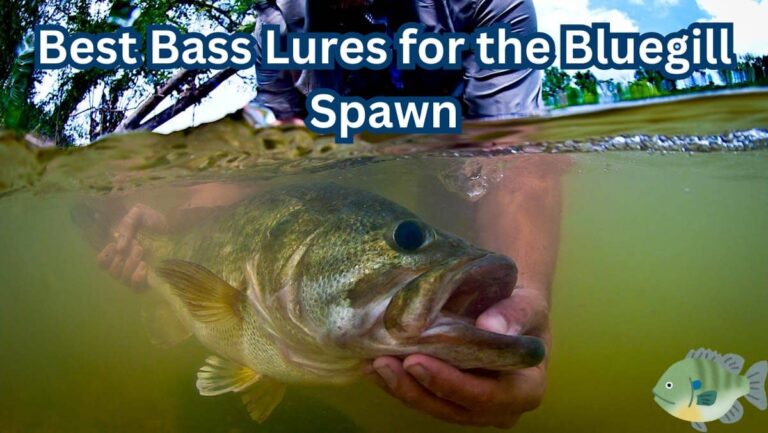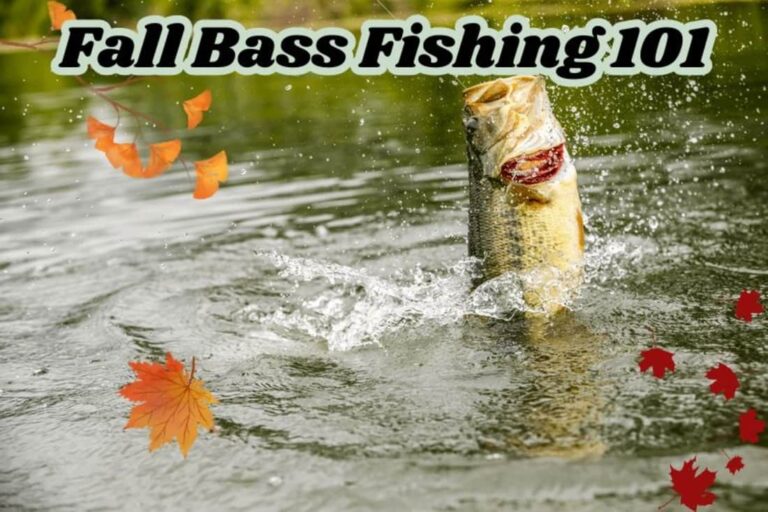Popping Frog vs Walking Frog Bass Fishing
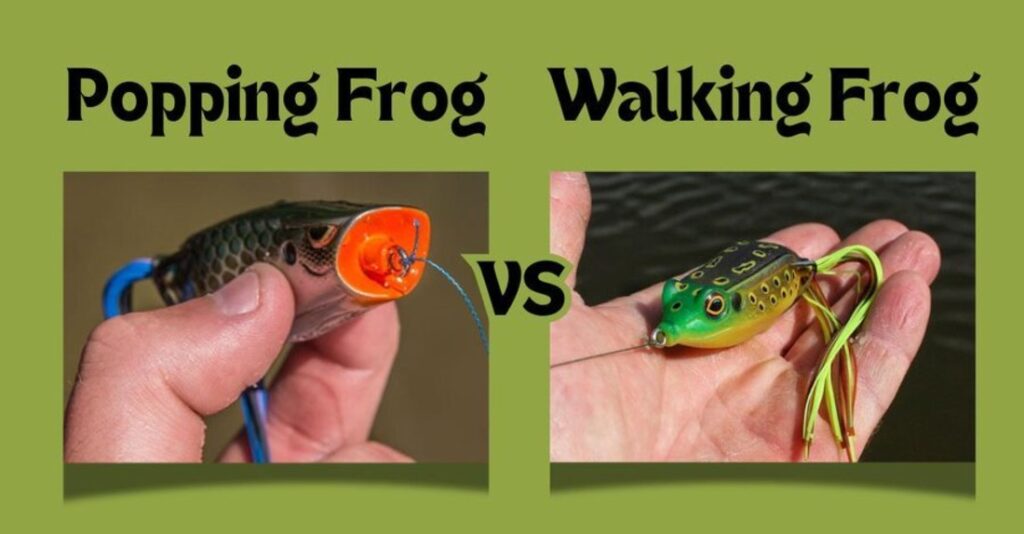
With frogs being one of the most popular lures in the fishing industry, a lot of guys over look the differences between popping frogs and walking frogs.
Heck, some guys don’t even know that there are two hollow body frog styles.
But understanding both of these frogs, how to use them, and when to use them will serve you very well.
Physical Design Differences
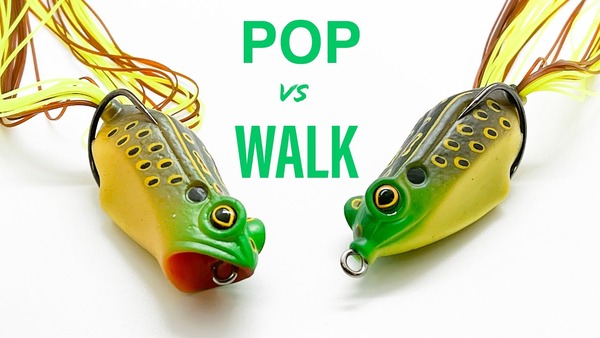
I’ll keep this part pretty short, because the design differences are quite obvious.
The popping frog has a cupped mouth or face.
This cupped design catches water and spits it forward as you twitch or pop the frog back to you.
This popping mouth also creates a lot of drag which allows you to fish a popping frog slower and keep it on one place longer.
The walking from has a pointy, boat shaped design. This causes the frog to smoothly glide forward or side to side when you are walking it in.
The pointy shape also helps the frog slide over heavy cover without catching anything.
Advantages of Popping Frogs
Also Read Best Popping Frogs of 2024
Louder
The popping and splashing of the popping frog makes a lot of sound and commotion on the surface.
This helps gets bass’s attention and draw them towards the lure.
Slower
This is a situational advantage, which I will further discuss shortly.
But the cupped mouth causes a ton of drag in the water, almost like a parachute does.
With every jerk or pop of your rod tip, the popping frog moves a very short distance and then comes to a stop.
This helps slow down the bait and give bass time to come eat it.
Advantages of Walking Frogs
Also Read Best Walking Frogs in 2024
Smooth and Snagless
The boat shaped design allows the walking frog to glide right over top of grass, lily pads, cheese, and other pond scum.
You can fish a walking frog over top of the thickest and slimiest vegetation easily.
The cupped mouth of a popping frog will catch and hang up on this thick stuff.
Faster
Like I said earlier, the speed of the frog is a situational advantage.
Sometimes, you want to cover more water and fish the bait faster.
Walking frogs glide quickly and easily on the surface, which allows you to fish them faster.
When to Use a Popping Frog
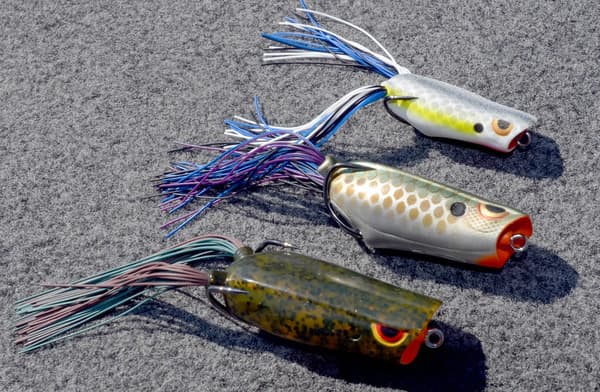
Sparse Cover or Deeper Water
When fishing in between sparse cover, you don’t need your frog to be quite as snagless.
Since you aren’t dragging it over thick slop, the popping frog is plenty weedless to deal with isolated cover.
It is better to add the drawing power of the popping sound and vibration. And it’s the same concept with a bit deeper water.
You might need to get the attention of bass that are a little deeper and farther away from the frog.
A loud popping frog will be much better at doing this than a silent walking frog.
Muddy Water
In muddy water, you always want to add some extra sound, vibration, or disturbance to your lures.
This helps the bass find and hone in on the bait with actually seeing it.
The splashing and popping is a very realistic and enticing sound that bass can easily find the source of.
Also, like I said above, you are able to fish popping frogs much slower.
This gives the bass time to locate your frog and makes it easier for them to actually eat it.
Early Morning and Evening
There are two reasons why a popping frog is better for the early morning and evening hours.
First, these times of day are much lower light periods of time.
This means it is harder for the bass to see, and the extra disturbance of the popping frog allows them to find the bait.
It is exactly the same concept as muddy water scenarios.
Second, bass have more energy and aggressive during these hours.
If they hear something loud and vulnerable, they won’t hesitate to go and eat it.
They are trying to feed up a lot while the temperatures are still cool and there is still enough light so efficiently find food.
Also Read: Frog Fishing in the Rain
When to Use a Walking Frog
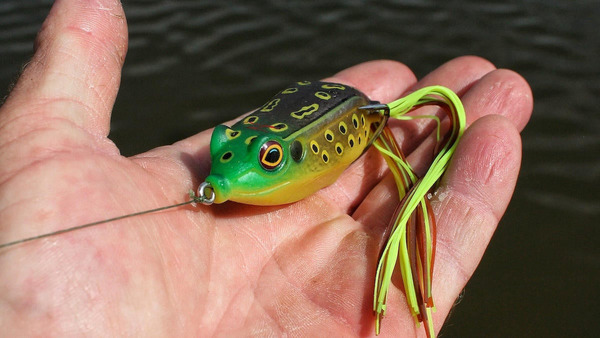
Heavy Cover and Matted Vegetation
It is very difficult to fish a popping frog in thick, matted vegetation. The cupped mouth catches on everything.
This cause the frog to flip, roll, snag, hop, and be very ineffective. But the pointed nose and mouth of a walking frog glide right over all of that thick slop.
This keeps your bait looking natural, in a consistent strike zone, and free of snags.
Clear, Shallow Water
Now, for the most part, you are always going to be fishing a frog in shallow water.
So you don’t really need to worry about that part. But when that shallow water is really clear, the walking frog typically outperforms the popping frog.
I think there are a couple reasons for this. First, the overall profile of walking frog is a big more natural.
They are shaped just like a bluegill, shad, or frog.
Second, walking frogs have a more fluent and natural walking motion.
This is to be expected, but their wide side-to-side walking motion is terrific for getting bass commit in high visibility water.
Covering Shallow Water
When you are fishing large, expansive areas of vegetation, it is key to have a walking frog so that you can cover more water.
Huge grass flats, long weed edges, expansive matted vegetation, or any other area where you are fishing tons of water.
Slowly popping a frog is almost not an option because you aren’t going to be able to cover enough water.
But quickly walking a frog along these areas helps you find the bass and fish every possible hole.
If You Could Only Have One
If you don’t have a big budget, or you are just getting into frog fish and don’t want to invest a bunch of money, you might want to start with just one type of frog.
If this is you, here’s how to tell which one you should get. If you are buying a frog so that you can fish heavy cover that you couldn’t possibly fish with any other lure, get a walking frog.
This is how a lot of guys approach frog fishing. Their bodies of water are full of thick vegetation and no other lure can get to where the bass are.
Now if your lakes and ponds don’t have super thick grass or vegetation and you are just trying to catch as many bass as possible, get the popping frog.
The popping frog is much more versatile and will get a lot more bites when you are fishing more open water.
So if you could only have one, you need to analyze your specific bodies of water.
If they have heavy vegetation, go with the walking frog. And if they have sparse or little vegetation, go with the popping frog.
Reeling this In
When bass fishing with frogs, you should definitely know which style to throw.
Popping frogs, with their cupped mouths, are ideal for creating noise and attracting bass in sparse cover, deeper water, and low-light conditions.
They allow for a slower, more deliberate approach, making them perfect for muddy waters and early morning or evening fishing.
On the other hand, walking frogs, with their streamlined design, excel in navigating heavy cover and matted vegetation, allowing for faster, more efficient coverage of large areas.
Ultimately, I highly recommend getting as much experience with both styles of frogs as possible.
Catch as many bass as you can on each of them and get a more personal feel for how and when to use each of them.
